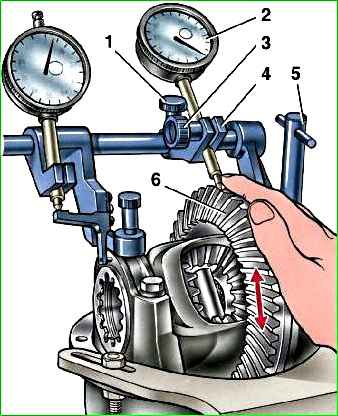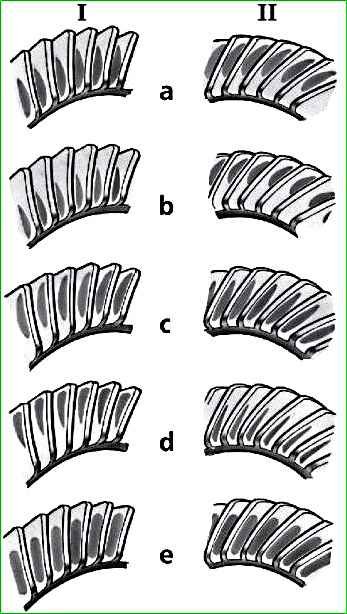Installing the differential case
Install the pre-assembled differential case together with the outer bearing rings in the crankcase

Install two adjusting nuts 4 (Fig. 1) so that they touch the bearing rings.
Install the bearing caps and tighten the mounting bolts with a torque wrench.
Preloading the differential box bearings and adjusting the lateral clearance in the final drive gear engagement
These operations are performed simultaneously using the A.95688/R tool and the A.55085 key.
Fasten the tool (Fig. 1) on the gearbox housing with screws 1 and 6, screwing them into the holes for the mounting bolts of the adjusting nuts lock plates.

Move bracket 7 along the guide of the device until lever 5 touches the outer side surface of the cover and tighten screw 8.
Loosen screws 1 and 3 (Fig. 2), and install bracket 4 so that the indicator leg 2 rests on the side surface of the tooth of the driven gear at the edge of the tooth, then tighten screws 1 and 3.
By turning the adjusting nuts, pre-adjust the lateral clearance between the teeth of the driving and driven gears within 0.08–0.13 mm.
Check the clearance using indicator 2 while rocking gear 6.
In this case, the bearings should not have a preliminary tension.
The adjusting nuts must only be in contact with the bearings, otherwise the correct measurement of the preload is disrupted.

Tighten the two bearing adjusting nuts in sequence and evenly, causing the differential bearing caps to diverge and, consequently, the distance "D" (Fig. 3) to increase.
This divergence is marked by indicator 9 (Fig. 1), the leg of which is acted upon by lever 5.
The differential box bearing adjusting nuts are tightened until the distance "D" (Fig. 3) increases by 0.14–0.18 mm.
Having set the exact preload of the differential box bearings, finally check the lateral clearance in the engagement of the main gear gears, which should not change.
If the clearance in the engagement of the gears is greater than 0.08–0.13 mm, then bring the driven gear closer to the driving gear or move it back if the clearance is smaller.
To maintain the set bearing preload, move the driven gear by tightening one of the bearing adjusting nuts and loosening the other by the same angle.
To perform this operation accurately, watch the indicator 9 (Fig. 1), which shows the value of the previously set bearing preload.
After tightening one of the nuts, the indicator reading will change, since the divergence "D" (Fig. 3) of the covers and the bearing preload will increase.
Therefore, loosen the other nut until the indicator arrow returns to its original position.
After moving the driven gear, check the side clearance using indicator 2 (Fig. 2).
If the clearance is not within the norm, repeat the adjustment.
Remove the A.95688/R device, install the locking plates of the adjusting nuts and secure them with bolts and spring washers.
Spare parts come with two types of locking plates: with one or two tabs, the plates are installed depending on the position of the slot nuts.
Adjustment and repair of gearbox units are performed on a stand, where you can also test the gearbox for noise and check the location and shape of the contact patch on the working surfaces of the teeth, as indicated below.
Checking the contact of the working surface of the teeth of the main transmission gears
For the final check of the quality of the engagement of the main transmission gears on the stand:
- - install the adjusted gearbox on the stand and lubricate the working surfaces of the teeth of the driven gear with a thin layer of lead oxide;
- - start the stand; use the stand levers to slow down the rotation of the installed half-axles so that under load on the surfaces of the driven gear teeth show traces of contact with the teeth of the driving gear;
- - change the direction of rotation of the stand and, braking, obtain traces of contact on the other side of the driven gear teeth, which corresponds to the backward movement of the car.
The engagement is considered normal if on both sides of the driven gear teeth the contact patch is evenly distributed closer to the narrow end of the tooth, occupying two thirds of its length and not extending to the top and base of the tooth, as shown in Fig. 4 "e".

Cases of incorrect divergence of the contact patch on the working surface of the tooth are shown in Fig. 4 (a, b, c, d).
To adjust the correct position of the drive gear with replacement of the ring, it is necessary to disassemble the unit.
During assembly, repeat all operations for pre-tensioning the roller bearings of the drive gear, checking the torque of resistance to rotation, pre-tensioning the roller bearings of the differential box and adjusting the lateral clearance of the engagement of the main gear gears.





